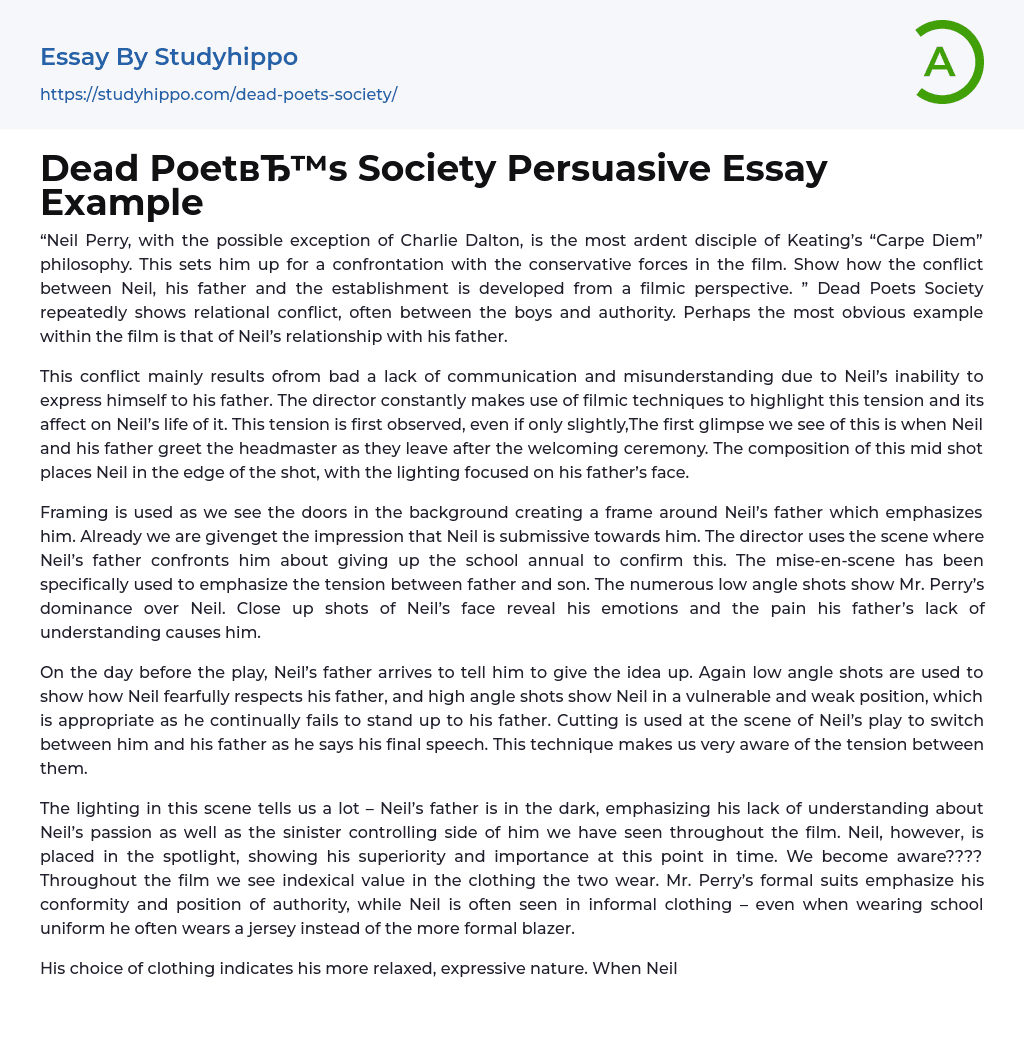“Neil Perry, with the possible exception of Charlie Dalton, is the most ardent disciple of Keating’s “Carpe Diem” philosophy. This sets him up for a confrontation with the conservative forces in the film. Show how the conflict between Neil, his father and the establishment is developed from a filmic perspective. ” Dead Poets Society repeatedly shows relational conflict, often between the boys and authority. Perhaps the most obvious example within the film is that of Neil’s relationship with his father.
This conflict mainly results ofrom bad a lack of communication and misunderstanding due to Neil’s inability to express himself to his father. The director constantly makes use of filmic techniques to highlight this tension and its affect on Neil’s life of it. This tension is first observed, even if only slightly,The fi
...rst glimpse we see of this is when Neil and his father greet the headmaster as they leave after the welcoming ceremony. The composition of this mid shot places Neil in the edge of the shot, with the lighting focused on his father’s face.
Framing is used as we see the doors in the background creating a frame around Neil’s father which emphasizes him. Already we are givenget the impression that Neil is submissive towards him. The director uses the scene where Neil’s father confronts him about giving up the school annual to confirm this. The mise-en-scene has been specifically used to emphasize the tension between father and son. The numerous low angle shots show Mr. Perry’s dominance over Neil. Close up shots of Neil’s face reveal his emotions and the pain his father’s lack of understanding causes him.
On the day before
the play, Neil’s father arrives to tell him to give the idea up. Again low angle shots are used to show how Neil fearfully respects his father, and high angle shots show Neil in a vulnerable and weak position, which is appropriate as he continually fails to stand up to his father. Cutting is used at the scene of Neil’s play to switch between him and his father as he says his final speech. This technique makes us very aware of the tension between them.
The lighting in this scene tells us a lot – Neil’s father is in the dark, emphasizing his lack of understanding about Neil’s passion as well as the sinister controlling side of him we have seen throughout the film. Neil, however, is placed in the spotlight, showing his superiority and importance at this point in time. We become aware???? Throughout the film we see indexical value in the clothing the two wear. Mr. Perry’s formal suits emphasize his conformity and position of authority, while Neil is often seen in informal clothing – even when wearing school uniform he often wears a jersey instead of the more formal blazer.
His choice of clothing indicates his more relaxed, expressive nature. When Neil and his father have a discussion in the study after the play, mise-en-scene aids us in plays an enormous role in allowing us to understanding the situation. Extreme low and high angles are used to show Neil and his father in dominant and vulnerable positions respectively. The books in the shelves create lines which highlight the authority and dominance of this place, and therefore Mr. Perry. The dim lighting and
the warm, inviting colours creates a warm, loving atmosphere.
This is in sharp contrast with and which jars harshly with the unkind way Mr. Perry is speaking to Neil and thehis lack of understanding he shows him. The climax of this dysfunctional relationship between father and son is reached in the scene where Neil takes his life. The combination of eerie music, exposing white light on Neil’s face and close up shots of his hands, the crown and the gun all create the expectation that something is about to happen. A major element to developing the conflict between Neil and his father is the development of Neil himself.
We are shown the times when Neil encourages Cameron to rip out the pages, calls Keating “Captain”, asks about the Dead Poets Society, calls its first meeting and chooses to audition for the play. This emphasizes that he does take a stand and reveals to us how bad his relationship with his father must be. The director has used many filming techniques to convey details about relationships subtly. In order to fully understand the relationship between Neil and his father, we need to be aware of this. Only then can we see how this all builds up to Neil’s suicide.
- Culture essays
- Social Control essays
- Citizenship essays
- Social Justice essays
- Caste System essays
- Social Responsibility essays
- Socialization essays
- Deviance essays
- Modern Society essays
- Popularity essays
- Civil Society essays
- Community essays
- Female essays
- Filipino People essays
- Igbo People essays
- Indigenous Australians essays
- Indigenous Peoples essays
- Minority Group essays
- Social Institution essays
- Men essays
- The nation essays
- Middle Class essays
- Social Norms essays
- Discourse Community essays
- Popular Culture essays
- Car Culture essays
- American Culture essays
- Mormon essays
- Indian Culture essays
- Mexican Culture essays
- Pop Culture essays
- Cultural Differences essays
- Culture Shock essays
- Different Cultures essays
- 12 Angry Men essays
- A beautiful mind essays
- A Separation essays
- Alfred Hitchcock essays
- American Beauty essays
- American Films essays
- Animation essays
- Avatar essays
- Blade Runner essays
- Bollywood essays
- Bond essays
- Bridge essays
- Cinema Of The United States essays
- Comedies essays
- David essays
- Dead Poets Society essays




